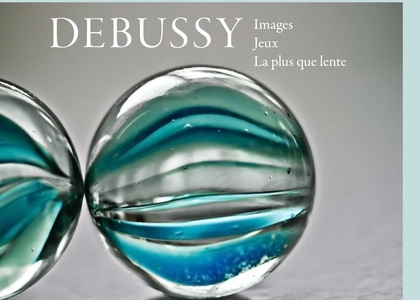> Vote for the classical album of 2016

The album performed by San Francisco Symphony, conducted by Michael Tilson Thomas, is broadcasted for the first time at CD Review on November 16 and 17
If you would like to
vote for this cd please vote HERE
Ever since the beginning of my career, the music of Debussy appealed to me.
The current musical conductor of the San Francisco Symphony, Michael Tilson Thomas, chose for this album three works that portray Claude Debussy's mastery in the art of orchestration, the suite Images, the danced poem Jeux and the waltz La Plus Que Lente.
The conductor declared: ever since the beginning of my career, the music of Debussy appealed to me. He was brilliant in finding the essential qualities of each orchestral instrument. Therefore the solo parts he has written are evocative, they became iconic. Moreover, Debussy has a strong sense of unusual mixtures of tones. It is his original and highly pretentious style. In fact, his orchestral music, especially his late works, is one of the greatest challenges of the entire symphonic repertoire, for both conductor and orchestra.
Debussy Album - a demonstration of colorful virtuosity
The recordings from this album were completed in 2013 and 2014 at Davies Symphony Hall in San Francisco and were published under the San Francisco Symphony Media logo. It is obviously the editing of the San Francisco Symphony, the one that created the albums of this ensemble and the one that, through the quality of the recording sessions, and beyond the merit of performance, contributed to winning the 8 Grammy Awards for the aforementioned albums.
Regarding the performance we will let conductor Michael Tilson Thomas say a few words: It was a personal pleasure to interpret this music along with the San Francisco Symphony. The members of this ensemble are gifted with all the artistry of a valuable orchestra and are willing to venture with enthusiasm in the universe filled with surprises of Debussy's orchestral music.
When talking about the waltz La Plus Que Lente, Michael Tilson Thomas said: It is a waltz in Chopin's shadow, that still takes you to a darkness that not even he explored. Debussy's orchestra seems to be an ensemble for a café - concert. He included the energy that brought that certain color over the state of meditation and bliss.
In my opinion, it is worth mentioning the version that the San Francisco Symphony, having Michael Tilson Thomas as a conductor, offers to the Images suite, work signed by Claude Debussy in 1912, the work consisting of three parts, inspired by folk music and the composer's impressions of three different countries, takes us to Scotland, rather sad and cold, in Gigue, with its distinctive theme interpreted by the oboe, then to Iberia, filled with Spanish traditional instruments in the most ambitious portrait of Spain with Debussy's mark on it, but it also takes us to France with a rustic perfume in Rondes de Printemps, with its changing textures and the flickering lights in Claude Monet's paintings.
Another demonstration of orchestral virtuosity is the danced poem "Jeux", completed by Debussy in 1913, specially for the sensation of that time, The Russian Ballet in Paris. The interpretation of this work is as visual as it can be. The San Francisco Symphony, conducted by Michael Tilson Thomas, succeeds in engaging the audience through the interplay of the dancers during the poem. The choreography imagined by Debussy through the orchestra is crystal clear. The small gestures of the kettle drums, along with the viola and the xylophone, the sound fluxes that curdle and crumbles following the scenic play of the ballet dancers, the controversy of the independent lining of the strings. Here are a lot of difficulties transformed by the Orchestra and the conductor into demonstrations of colorful virtuosity, of graduation of intensities with extremely fine measures, in order to emphasize the show that is, in fact, just a "game".
Here are just a few arguments for which I invite you to listen to these recordings broadcasted in premiere at Radio România Muzical at CD Review (12, 15) on November 16 and 17.
Translated by Vorotneac Ruxandra
MTTLC 1st year University of Bucharest














